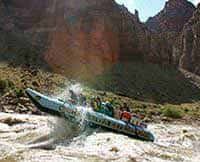2023 High Water in Cataract Canyon
Most likely, you have heard or seen the news reports that have shifted from dire predictions about a drought in the Western United States to reports of record-setting snowfall in the mountains. It has truly been a roller-coaster ride, but right now we are at the top of the roller coaster and getting ready to head down the slope.
While this snowpack won’t have as much effect on our Grand Canyon, Desolation Canyon, Idaho, and Oregon trips, we are expecting very high water on the Colorado River through Cataract Canyon this year. A study of the history of high-water flows through Cataract Canyon shows that the “peak,” or the date on which the river reaches its highest flow, ranges anywhere from late May to the end of June with high flows persisting even into the middle of July.
What does this mean for 2023 Cataract Canyon trips within this date range? It means that on our 4-Day Cataract Canyon trips, we will be operating our large, J-Rig style rafts identical to the boats we operate all of the time in the Grand Canyon. Western’s J-Rig is designed to handle big water, and there are plenty of seating options available from more thrilling to more tame.
For guests planning to join us on our Cataract Canyon 2-Day Express trips, we will be using our standard high-speed snout rigs which we have used for many years in high water conditions.
Cataract Canyon, in high water, is some of the largest and best whitewater in North America. It flows fast and turbulent. It is important that those taking this trip are in good health, and, although it is very rare for a passenger to end up in the water, it is important that all participants are prepared to swim and assist in their own rescue if necessary.
For many, the opportunity of rafting Cataract Canyon at higher water enhances the excitement for these upcoming trips. If this describes you and you haven’t already booked your spot for this record-setting year, there are still some spots available on our Cataract Canyon 4-Day Expedition and our Cataract Canyon 2-Day Express Trips.
You may also wish to consider joining us later in the summer during late July or August when the higher flows have reduced. During this time frame, we’ll likely be using our oar boats and paddle rafts. Either way, you’ll still get to experience the stunning scenery of the Colorado River through Canyonlands National Park, delicious riverside meals, sleeping under the stars, and the much-needed respite that comes with every Western River Expedition.
We look forward to seeing you on the river!
Respectfully,
Brian I. Merrill - CEO













